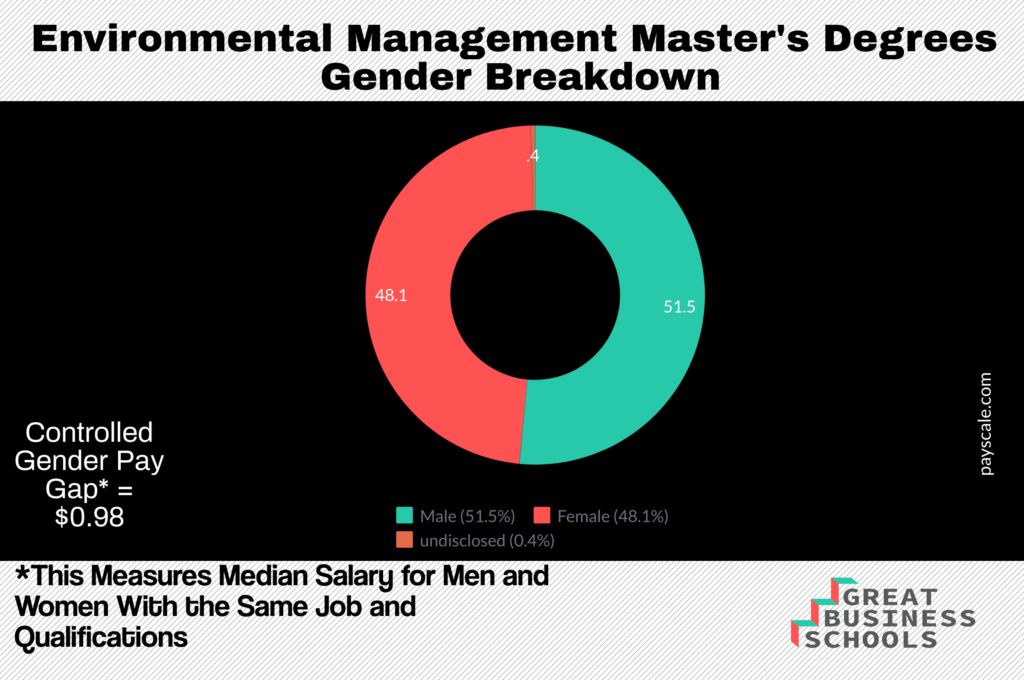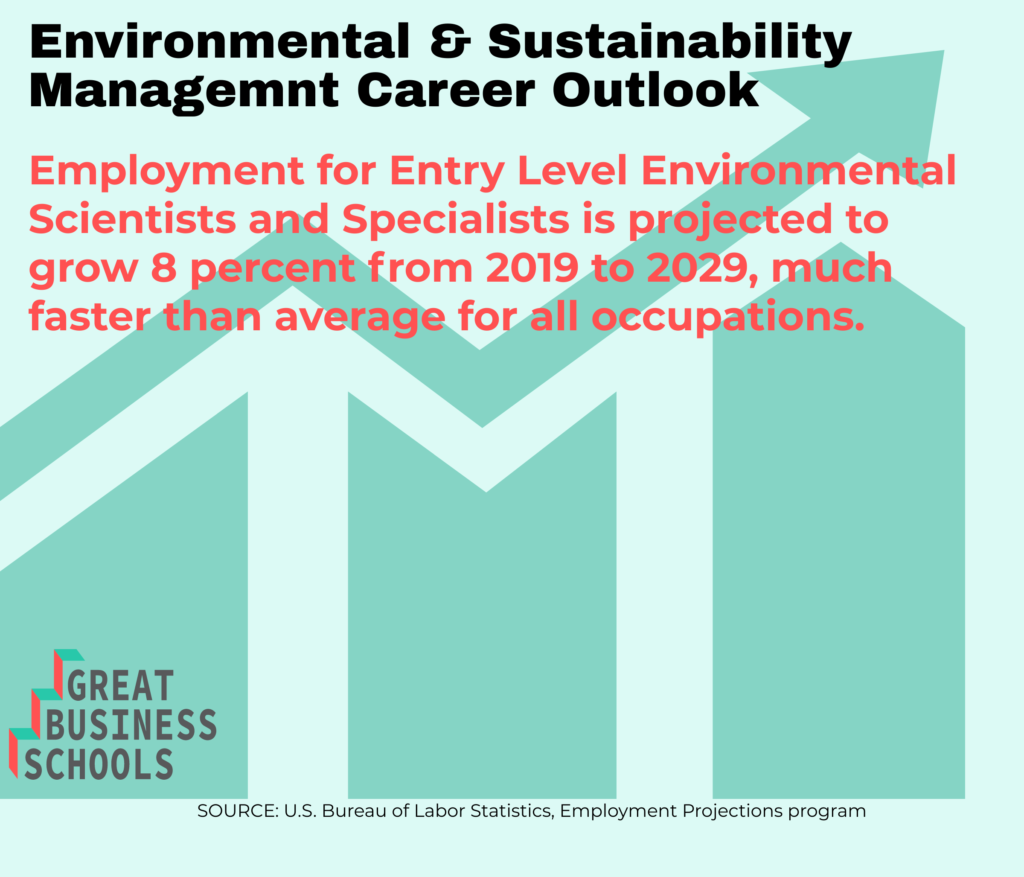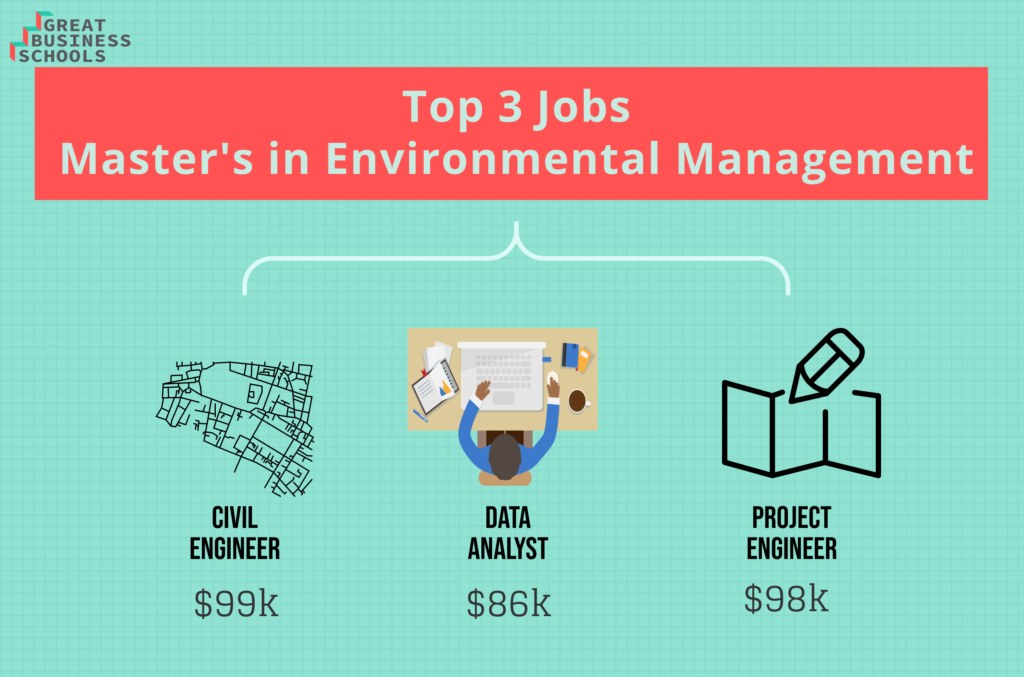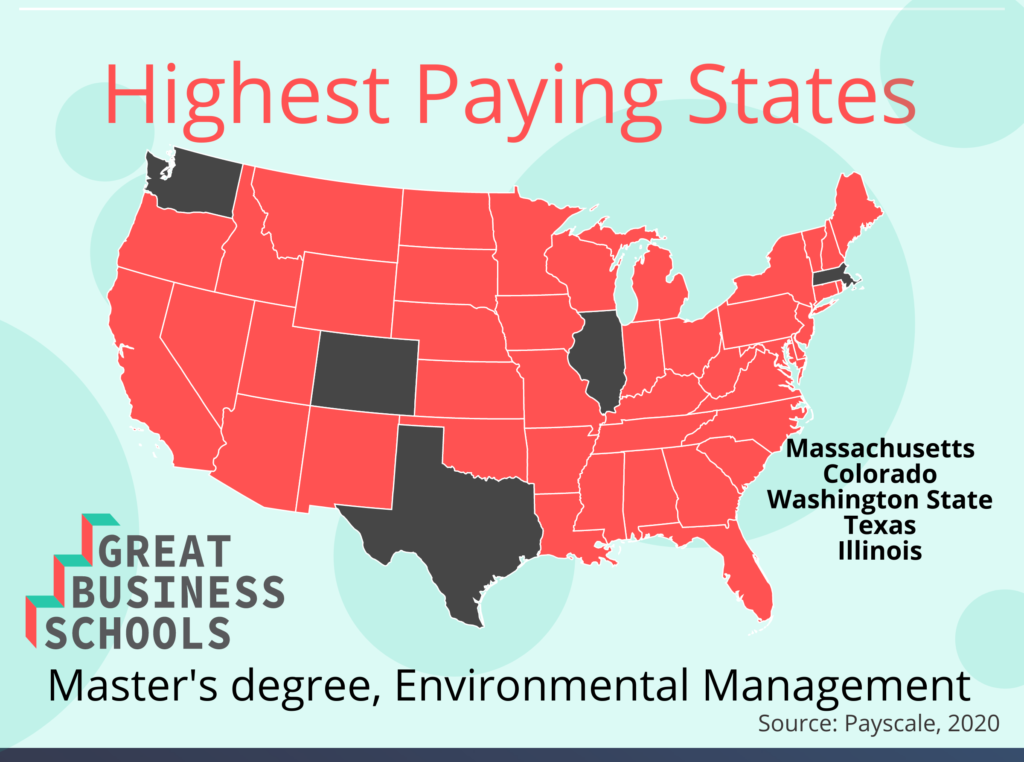With climate change looming over modern civilization, there’s very little doubt that careers in environmental management and sustainability are only going to grow. Quite simply, they have to. So are you a working professional in the environmental sustainability field looking for advancement, or a graduate student with an interest in the field of environmental management? Have sought to answer these questions?
- What is environmental management and sustainability?
- What is sustainability management and how does it differ from environmental management?
- What is a sustainability manager and what are their primary job responsibilities?
Environmental management is a fast-growing field that encompasses the many ways businesses and organizations can proactively apply practical and systematic approaches in an effort to reduce the negative impacts manufacturing and business processes have on the earth and its many integrated environments.
The reality is environmental management is a business necessity because most business sectors are mandated to follow environmental law. Laws like the Clean Air Act (CAA) regulate the impact that any one organization or business can have on the public’s health based on the quality of environmental factors.

Environmental managers are tasked with the responsibility of finding and improving techniques to conserve water, energy and other materials/chemicals that are harmful to some part or all of the environment. Environmental management is often done in compliance with legislation set forth by state and federal agencies engaged to protect the environment for the children of today and the future.
Environmental managers seek to accomplish two primary objectives –
- To protect the environment from impact of manufacturing by-products.
- To protect the business or organization from the penalties and consequences of not complying with environmental legal mandates.
Accreditation for Environmental Management Programs
The process of accreditation is essentially a formalized educational quality control process. The process assesses higher learning institutions and programs to confirm that schools and programs advertised are the same educational experience that is delivered. In the United States, there are two fundamental categories of accreditation – that Regional and that of Specialized accreditation.
Accreditation at the Regional Level
A school, university or college that receives regional accreditation has complied with the educational and institutional standards as set forth by the federal government’s six regional agencies.
- Middle States Commission of Higher Education (MSCHE)
- WASC Senior College & University Commission (WSCUC)
- Northwest Commission on Colleges & Universities (NWCCU)
- Southern Association of Colleges & Schools Commission on Colleges (SACSCOC)
- New England Commission on Higher Education (NECHE)
- The Higher Learning Commission (HLC)
Accreditation at the Specialized Level
Accreditation at the specialized level is typically administered by industry-sanctioned professional agencies that are sanctioned separately by each industry. Unlike regional accreditation, specialized accreditation is voluntary and is a process that often has more stringent standards than its regional counterpart.
Programmatic Accreditation for Environmental Management & Sustainability Programs
Although many master’s degree program have their programs voluntarily accredited at the specialized level by independent, neutral evaluators, at present there are no accreditation agencies that evaluates coursework for environmental management programs.
As such, students and interested working learners are advised to confirm that the school and/or programs have met all available accreditation statuses that represent academic excellence. It is noted that there are academic degree programs in environmental management that may be accredited from an engineering perspective (i.e., ABET), or a management perspective (i.e., AACSB, etc.), among others.

Types of Masters of Environmental Management and Sustainability Degrees
A masters in sustainability and environmental management degree program is typically delivered as an interdisciplinary academic degree pulling from the disciplines of physical science, the law, and business, among others. Because of this inherent diversity, there are a variety academic and professional specialties within a masters program in sustainability.
Based on the ongoing (and escalating) issues of climate change, a masters degree in sustainability and environmental degree is increasingly becoming of vital importance and an in-demand field of study.
Online Programs in Environmental Management
An Environmental and Sustainability Management Masters’ degree that you earn online will provide you with the same skills and benefits that you would receive if you enrolled in a degree program that was being offered in a classroom. The main difference between an online degree program and a traditional program taught in a classroom is the convenience and the flexible schedule. Being able to study when it is most convenient for the student makes it possible for the student to take advantage of every possible learning opportunity.
Another advantage of online learning is that you can take your classes from any location that has an internet connection. You can attend the college of your choice as long as they offer your classes online. You can take your classes while you are on vacation or while you are on break at work. Online courses give you the benefit of a quality education with the convenience of being able to study when it is most beneficial for you. Being able to study when you have the extra time eliminates the stress of having to meet a strict classroom schedule.
Consider this sampling of masters programs in sustainability concentrations, which also includes options for online masters in sustainability and environmental options –
Concentration Options for On-campus and Online Masters in Environmental Management and Sustainability
Energy & The Environment
A master’s in sustainability online degree that specializes in energy offers a deep exploration of the environmental consequences of both traditional energy sources, plus the exploration of emerging, cleaner energy sources. Students in a master of environmental management sustainability program explore the challenges of globally distributing energy both fairly and cleanly.
Environment Policy
Students enrolled in a masters program in sustainability and management with a specialty in environment policy study current policies that impact the use/allocation of natural energy resources. masters in sustainability programsseek to teach students how to enact future policies that balance opposing interests for energy, while finding solutions to maintain ecologically-wise and sustainable strategies.
The Environment and Business
Many students interested in the business perspective of environmental management choose to earn an on-campus or online masters in sustainability and management degree, with a business concentration. Many masters programs in sustainability and management are dual programs that offer an MBA (Master of Business Administration) degree option simultaneously.
Water Resource Science
Students enrolled in a masters degree in sustainability with a water resource science emphasis explore the issues surrounding water pollution, and scarcity. They work to identify how humans and climate change is impacting the availability of life-sustaining water across the planet
Land Conservation/Ecosystem
Degree candidates for a masters in sustainability online or on-campus degree explore energy resource allocation, biodiversity conservation and sustainable land use. Coursework for these types of masters in sustainability programsexplores the socio-ecological systems that impact both rural and urban landscapes.
Certifications/Licenses
Many professionals choose to earn environmental manager certifications or sustainability management certificate credentials to refine their educational, further their knowledge and to open potentially better-paying environmental management job opportunities. Some select to earn environmental management certificates offered on-campus or an online graduate certificate in sustainability or a graduate certificate in environmental management and sustainability.
The Sustainability Professional Certification (SPC)
The International Society of Sustainability Professionals offers several environmental management certificates options known as the four SPC – the Sustainability Professional Certification. These include these certificate in sustainability management options –
- The Sustainability Excellence Professional (SEP)
- The Certified Sustainability Professional (CSP)
- The Sustainability Excellence Associate (SEA)
- The Sustainability Associate (SA)
The Certified Environmental Auditor (CEA)
This certificate in sustainability management is offered by the National Registry of Environmental Professional, an organization that was established in 1987. The CEA exam covers environmental topics like regulations/law, environmental technology, ethics and geology, among others.
The Registered Environmental Manager (REM)
The Registered Environmental Manager certification if offered by the by the National Registry of Environmental Professional. This is considered an initial certification for those entering the environmental management industry. To be eligible, test-takers must possess a baccalaureate degree in a related topic – with five years of professional experience, or a dozen years of experience if the professional has no academic degree.

Careers in Environmental Management and Sustainability
Because of the depth and the breadth of the many masters in sustainability jobs, students and degree candidates have multiple paths from which to choose.
Many jobs in environmental sustainability management require students to focus their academic studies to address specific environmental challenges specific to a region or a population. As you consider the many career opportunities in sustainability or the varying jobs in sustainability management, be certain your choice of degree program will lead to a career in environmental sustainability that meets your career objectives.
As you weigh and compare your education options, consider these careers in sustainability management, which require applicants to hold a master’s degree to be eligible to apply for these careers in environmental sustainabilityand management –
Jobs in Sustainability Management
Conservation Scientist
One of the most popular careers in environmental sustainability is that of a conservation scientist. A conservation scientist is tasked with the responsibility of managing the allocation and use of natural resources as well as the exploration of sustainable solutions for areas or populations overconsuming energy.
Natural Sciences Manager
A natural sciences manager supervises and coordinates with environmental program directors to ensure budgetary resources meet the needs of the communities and populations being served.
Environmental Scientist
Environmental specialists are a sustainability management career option that allows professionals to work in government agencies and organizations to mitigate the negative impact on the environment by daily activities. s of daily activities on the environment. Jobs in environmental sustainability in this specialty will often facilitate in the reclaiming of water, air and land decimated from natural disasters and/or pollution.
Hydrologist
A Hydrologist is a professional with a career in environmental sustainability dedicated to mitigating the impact on the environment caused by water-related issues like droughts, erosion and flooding, among other events. A hydrologist seeks to improve the access to drinking water across the globe.
Environment Engineer
Environmental engineers offer a career in environmental sustainability that allows professional to help solve environmental concerns causes by air pollution, soil erosion and water pollution.
Agriculture Engineer
Agricultural engineers are tasked with the responsibility of solving issues that relate to power supply and environmental issues.
Salary Potential for Environmental Management
The Bureau of Labor Statistics (BLS), a federally-run statistician agency dedicated to labor and employment data summarizes the occupational outlook for many environmental and sustainability management professionals across several categories. Additionally, because some masters in sustainability management salary job options require more specialized training, and therefore, may offer higher sustainability analyst salaries.
Here is how the BLS breaks down the various sustainability engineering salary or sustainability coordinator salarydifferentials –
Natural Sciences Manager
According to the Bureau of labor Statistics, in 2019, there were more than 70,000 natural sciences managers working in the United States, with a median sustainability consultant salary of $129,100 per year. The statisticians at the BLS anticipate the job growth for a natural sciences manager (or the growth of a sustainability directory salary package) to be about 5% a bit faster than the average anticipated growth for all U.S. jobs combined.
It is helpful to review the sustainability consulting salary percentile data as follows –
| Salary Percentile Data for Sustainability Analyst Salary | Director of Sustainability Salary/Natural Sciences Manager | Director of Sustainability Salary |
|---|---|---|
| 10% | $ 66,050 per year | $ 31.76 per hour |
| 25% | $ 94,940 per year | $ 45.65 per hour |
| 50% | $ 129,100 per year | $ 62.07 per hour |
| 75% | $ 176,510 per year | $ 84.86 per hour |
| 90% | $ 208,000+ per year | $ 100.00+ per hour |
The top-paying states for natural science managers are as follows –
| Top Paying States | Number of Jobs | Sustainability Consultant Salary |
|---|---|---|
| New Jersey | n/a | $ 190,240 per year |
| California | n/a | $ 188,710 per year |
| Massachusetts | 3,870 | $ 181,720 per year |
| Connecticut | 630 | $ 168,060 per year |
| New York | 1,450 | $ 159,600 per year |
Environmental Scientist/Sustainability Director or Analyst
According to the Bureau of labor Statistics, in 2019, there were more than 90,000 environmental scientists and specialists working in the United States, with a median sustainability director salary of $ 71,360 per year. The statisticians at the BLS anticipate the job growth for an environmental scientist/sustainability director to be about 8% (through 2029, faster than the average anticipated growth for all U.S. jobs combined.
| Salary Percentile Data for Sustainability Engineer Salary | Chief Sustainability Officer Salary – Environmental Scientist | Chief Sustainability Officers Salary |
|---|---|---|
| 10% | $ 42,810 per year | $ 20.58 per hour |
| 25% | $ 54,100 per year | $ 26.01 per hour |
| 50% | $ 71,360 per year | $ 34,31 per hour |
| 75% | $ 95,140 per year | $ 45.74 per hour |
| 90% | $ 124,760 per year | $ 59.98 per hour |
The top-paying states for environmental scientists are as follows –
| Top Paying States | Number of Jobs | Sustainability Consultant Salary |
|---|---|---|
| District of Columbia | 1,790 | $ 112,540 per year |
| California | 14,380 | $ 92,320 per year |
| Washington | 3,040 | $ 85,870 per year |
| Virginia | 3,270 | $ 85,660 per year |
| Colorado | 2,420 | $ 84,690 per year |
Conservation Scientist
According to the Bureau of labor Statistics, in 2019, conservation scientists a median sustainability analyst salary of $ 62,660 per year.
It is often helpful to review the conservation scientist or sustainability consultant salary percentile data as follows –
| Salary Percentile Data for Sustainability Analyst Salaries | Chief Sustainability Officers Salary/Conservation Scientist | Chief Sustainability Officer Salary |
|---|---|---|
| 10% | $ 39,270 per year | $ 18.88 per hour |
| 25% | $ 49,480 per year | $ 23.79 per hour |
| 50% | $ 62,660 per year | $ 30.12 per hour |
| 75% | $ 79,630 per year | $ 38.28 per hour |
| 90% | $ 98,060 per year | $ 47.14 per hour |
The top-paying states for conservation scientists are as follows –
| Top Paying States | Number of Jobs | Sustainability Consultant Salary |
|---|---|---|
| District of Columbia | 150 | $ 93,670 per year |
| Connecticut | 50 | $ 89,400 per year |
| New Jersey | 310 | $ 87,970 per year |
| Maryland | 360 | $ 82,130 per year |
| California | 1,760 | $ 80,510 per year |
Hydrologist
According to the Bureau of labor Statistics BLS, in the calendar year 2019, there were more than 7,000 hydrologists employed in the U.S., with a median sustainability analyst salary of $ 81,270 per year. The statisticians at the BLS anticipate the job growth for a natural sciences manager (or the growth of a sustainability director salary package) to be about 5% (through 2029), about as fast as predicted for the average anticipated growth for all U.S. jobs combined.
It is helpful to review the hydrologist or sustainability engineering salary percentile data as follows –
| Salary Percentile Data for Hydrologist | Chief Sustainability Officers Salary/Hydrologist | Hydrologist – Chief Sustainability Officer Salary |
|---|---|---|
| 10% | $ 51,220 per year | $ 24.62 per hour |
| 25% | $ 63,650 per year | $ 30.60 per hour |
| 50% | $ 81,270 per year | $ 39.07 per hour |
| 75% | $ 104,280 per year | $ 50.14 per hour |
| 90% | $ 127,400 per year | $ 61.25 per hour |
The top-paying states for hydrologist professionals are as follows –
| Top Paying States | Jobs | Sustainability Consultant Salary |
|---|---|---|
| New Jersey | 160 | $ 114,950 per year |
| Georgia | 70 | $ 106,710 per year |
| Maryland | 100 | $ 101,630 per year |
| California | 930 | $ 99,250 per year |
| Colorado | 460 | $ 95,660 per year |
Environmental Engineer
According to the Bureau of labor Statistics BLS, in the calendar year 2019, there were more than 54,000 environmental engineers employed in the U.S. The median sustainability engineer salary for 2019 was 88,860. The statisticians at the BLS predict statistically that the job growth for environmental engineers is to be about the same as the average growth for all United States occupations combine – at 3% through 2029.
It is helpful to review the hydrologist or sustainability engineering salary percentile data as follows –
| Salary Percentile Data for Environment Engineer | Chief Sustainability Officers Salary/Hydrologist | Hydrologist – Sustainability Consulting Salary Per Hour |
|---|---|---|
| 10% | $ 54,330 per year | $ 26.12 per hour |
| 25% | $ 68,000 per year | $ 32.69 per hour |
| 50% | $ 88,860 per year | $ 42.72 per hour |
| 75% | $ 114,250 per year | $ 54.93 per hour |
| 90% | $ 142,070 per year | $ 68.30 per hour |
The top-paying states for environmental engineers are as follows –
| Top Paying States | Jobs | Sustainability Consultant Salary – Environmental Engineer |
|---|---|---|
| Texas | 3,250 | $108,350 per year |
| Idaho | 340 | $106,360 per year |
| Washington | 1,900 | $104,740 per year |
| California | 8,640 | $104,260 per year |
| Maryland | 1,280 | $104,180 per year |
Finally, it is important to look at some additional related occupations that may offer environmental management and sustainability students a segue into a related field.
| Environmental Scientist Job Type | 2019 Median Salary | 2019 Median Salary | Anticipated Job Growth Thru 2029 |
|---|---|---|---|
| Biochemists & Biophysicists | $ 94,490 Per Year | $ 45.43 Per Hour | 4% |
| Geoscientists | $ 92,040 Per Year | $ 44.25 Per Hour | 5% |
| Chemical Engineers | $ 108,770 Per Year | $ 52.30 Per Hour | 4% |
| Occupational Health & Safety Specialists and Technicians | $ 70,480 Per Year | $ 33.88 Per Hour | 4% |
| Zoologists & Wildlife Biologists | $ 63,270 Per Year | $ 30.42 Per Hour | 4% |

Professional Organizations
Each industry typically set forth oversight and professional organizations that help support the industry as a whole and the professionals who work within that specific industry. Professional organizations are typically the voice and advocating body to ensure the industry operates optimally and that its professionals meet certain education and credentials to represent the industry. Additionally, a professional organization may offer its members benefits that include –
- Education and networking events.
- Mentorships.
- Domestic and International Conferences.
- Job boards, to name a few.
Additionally, a professional organization includes members from the various sectors of one primary industry, and facilitates effective communication among its members as they work together identify issues and solve and share solutions.
The NAEM – National Association of Environmental Management
The National Association of Environmental Management offers members a yearly conference that is often used as credit towards continuing education requirements for certain environmental industry certifications. The NAEM’s mission is to empower corporate leaders to be proper stewards of a health environment for today and future generations.
The NAEP – National Association for Environmental Professionals
The National Association for Environmental Professionals, founded in the late 1970s, provides its members a host of seminars, conferences, job boards, and continuing education coursework. As a professional organization dedicated to promoting the highest industry standards in terms of proficiency and ethics. In addition, the NEP has been publishing a quarterly journal for many decades in support of environmental management professionals. The NAEP offers a variety of members from a general member to student memberships and emeritus members as well.
The SWCS – the Soil & Water Conservation Society
Members have full access to the Journal of Soil and Water Conservation, which contains the latest conservation news and research, an exclusive career center, and several educational, networking, and professional training opportunities. Founded about ¾ of a century ago, the Soil and Water conservation Society represents educational and nonprofit organizations seeking to create science-based conservation practices and policies.
The SETC – the Society of Environmental Toxicology & Chemistry
The Society of Environmental Toxicology & Chemistry is a global professional organization with more than 5,000 members from more than 85 countries. The SETC acts as a forum where members can exchange ideas in the quest to find sustainable solutions for ongoing environmental issues on a global scale. The SETC is dedicated to the dissemination of research and solutions to help environmental challenges plaguing the earth and its many communities and populations. The SETC stands for the advancement of environmental professionals seeking to better manage and conserve the earth’s natural resources.
Carrie Morris
Author
Warren Dahl
Editor-in-Chief

